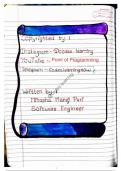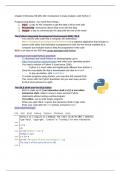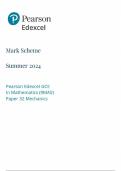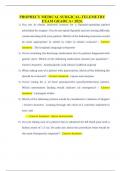INTERNATION FINANCIAL ACCOUNTING
Lecture 1
Why financial accounting?
- We want accounting because we want to measure
Measure what?
- Assets
- Liabilities
- Value
Information users
,Constituents of Financial Accounting
Main reports:
- Statement of comprehensive income or consolidated income statement
- Statement of cash flow or consolidated cash flow
- Statement of financial position or consolidated balance sheet
- Consolidated statement ofchanges in equity
Part 2 Earnings and valuations
Clean surplus accounting relation
- What is the relation between financial and operating functions and valuations?
o How a company is using these assets to create earnings
Clean Surplus Accounting Relation has the answer
Feltham & Ohlson, 1995
- In a “going concern” firm there are four key “flow” variables in each period
o Operating earnings (includes revenues, cost of goods sold, R&D expenses, etc.)
o (net) interest revenue (expenses)
o Cash flows
o Dividend payments
› What does operating assets represent?
balance sheet items such as: accounts receivables, inventory, prepaid expenses,
property, plant and equipment net of depreciation, operating liabilities such as
accounts payable and accrued wages
› What does operating earnings constitute?
income statement items such as sales, cost of goods sold, selling and administrative
expenses, etc.
› Operating assets (oa) generate the operating income (ox) and transfer the proceeds (cash) to
financial assets at the end of the period
› How earnings are produced in each period?
(net) operating assets
(net) financial assets (i.e. marketable securities minus debt)
› Book value (sum of operating and financial assets) represents owner’s equity
The book value is given as:
book value=financial assets+operating assets
› The earnings is given as:
earnings=operating earnings+ interest revenues(expenses)
, › The clean surplus relation is given as follows
book value ( t )=book value ( t−1 ) +earnings (t )−dividends(t )
Two key points to understand in this model
› Since dividends are declared and paid at the end of each period they directly reduce the
book value -> earnings comes first, before dividends
› However, they have no effect on the current period’s earnings
Why?
› Because the earnings was generated between the period t-1 and t for the given bv, which is
net of dividends of the previous period
Clean surplus accounting to dividends
› The dividends from the financial assets is given as
¿t =cash t + R f fin . assets ( t−1 )−fin . assets(t )
Rf is the risk free discount rate denoted by (1+risk free rate)
No calculations in exam
Present value relation of dividends
future÷.= present fin . assets+ futureCash ¿ operations .
Value of a firm depends on:
› Value of its financial assets which has relations with book value
› Value of the firm’s operating activities as determined by the present value of expected
(future) cash flows
Miller & Modigliani, 1961
Key assumptions behind PV models
› Perfect market
no buyer or seller of securities is large enough for his transactions to have an
appreciable impact on the then ruling price
› Rational behavior
investors always prefer more wealth to less and are indifferent as to whether a
given increment to their wealth takes the form of cash payments or an increase in
the market value of their holdings of shares
, In real world not possible to meet all these assumptions in the real world. There is no perfect market
in de world. Because investors can buy huge amount of stock in the market and then demand stays
the same, price goes up.
Dividend discount model
1
Market value j (t )= [¿ ( t ) + Market value j (t+1)]
1+disc . rate(t ) j
› j is the asset or any firm
› ¿ j ( t ) is the dividends per share paid by firm j during period t
› Market value j (t ) is the value (ex any dividend in t−1) of a firm j at the start of period t
› discount rate is the cost of capital and independent of j (i.e. risk free rate)
This model tells us that with this specific discount rate how much is the cost op capital, independent
of risk free rate.
What we want from this model: calculate market value based on the discount model.
Dividend policy puzzle
› A firm’s total market value is independent of its dividend policy
Miller & Modigliani, 1961
› Assuming this theory is correct, is the value of a firm that pays no dividend is the same as the
firm that pays constant rate of dividend, ceteris paribus?
Fischer Black and Myron Scholes (1974) found in their empirical study of NYSE stocks that “it is not
possible to demonstrate, using the best possible methods, that the expected returns on high yield
common stocks differ from the expected returns on low yield common stocks either before or after
taxes.
Part 3 Value relevance of financial accounting and accounting for Intangibles
Value relevance
› What is Value Relevance?
Financial accounting figures such as earnings, cash and book value of equity should
have a high degree of association with the firms’ stock price
› How do empirical studies detect Value Relevance?
Using regression coefficients and R2 (otherwise known as “coefficient of
determination”)
Lev and Zarowin (1999)
Intangibles are patents/trademarks.
Lecture 1
Why financial accounting?
- We want accounting because we want to measure
Measure what?
- Assets
- Liabilities
- Value
Information users
,Constituents of Financial Accounting
Main reports:
- Statement of comprehensive income or consolidated income statement
- Statement of cash flow or consolidated cash flow
- Statement of financial position or consolidated balance sheet
- Consolidated statement ofchanges in equity
Part 2 Earnings and valuations
Clean surplus accounting relation
- What is the relation between financial and operating functions and valuations?
o How a company is using these assets to create earnings
Clean Surplus Accounting Relation has the answer
Feltham & Ohlson, 1995
- In a “going concern” firm there are four key “flow” variables in each period
o Operating earnings (includes revenues, cost of goods sold, R&D expenses, etc.)
o (net) interest revenue (expenses)
o Cash flows
o Dividend payments
› What does operating assets represent?
balance sheet items such as: accounts receivables, inventory, prepaid expenses,
property, plant and equipment net of depreciation, operating liabilities such as
accounts payable and accrued wages
› What does operating earnings constitute?
income statement items such as sales, cost of goods sold, selling and administrative
expenses, etc.
› Operating assets (oa) generate the operating income (ox) and transfer the proceeds (cash) to
financial assets at the end of the period
› How earnings are produced in each period?
(net) operating assets
(net) financial assets (i.e. marketable securities minus debt)
› Book value (sum of operating and financial assets) represents owner’s equity
The book value is given as:
book value=financial assets+operating assets
› The earnings is given as:
earnings=operating earnings+ interest revenues(expenses)
, › The clean surplus relation is given as follows
book value ( t )=book value ( t−1 ) +earnings (t )−dividends(t )
Two key points to understand in this model
› Since dividends are declared and paid at the end of each period they directly reduce the
book value -> earnings comes first, before dividends
› However, they have no effect on the current period’s earnings
Why?
› Because the earnings was generated between the period t-1 and t for the given bv, which is
net of dividends of the previous period
Clean surplus accounting to dividends
› The dividends from the financial assets is given as
¿t =cash t + R f fin . assets ( t−1 )−fin . assets(t )
Rf is the risk free discount rate denoted by (1+risk free rate)
No calculations in exam
Present value relation of dividends
future÷.= present fin . assets+ futureCash ¿ operations .
Value of a firm depends on:
› Value of its financial assets which has relations with book value
› Value of the firm’s operating activities as determined by the present value of expected
(future) cash flows
Miller & Modigliani, 1961
Key assumptions behind PV models
› Perfect market
no buyer or seller of securities is large enough for his transactions to have an
appreciable impact on the then ruling price
› Rational behavior
investors always prefer more wealth to less and are indifferent as to whether a
given increment to their wealth takes the form of cash payments or an increase in
the market value of their holdings of shares
, In real world not possible to meet all these assumptions in the real world. There is no perfect market
in de world. Because investors can buy huge amount of stock in the market and then demand stays
the same, price goes up.
Dividend discount model
1
Market value j (t )= [¿ ( t ) + Market value j (t+1)]
1+disc . rate(t ) j
› j is the asset or any firm
› ¿ j ( t ) is the dividends per share paid by firm j during period t
› Market value j (t ) is the value (ex any dividend in t−1) of a firm j at the start of period t
› discount rate is the cost of capital and independent of j (i.e. risk free rate)
This model tells us that with this specific discount rate how much is the cost op capital, independent
of risk free rate.
What we want from this model: calculate market value based on the discount model.
Dividend policy puzzle
› A firm’s total market value is independent of its dividend policy
Miller & Modigliani, 1961
› Assuming this theory is correct, is the value of a firm that pays no dividend is the same as the
firm that pays constant rate of dividend, ceteris paribus?
Fischer Black and Myron Scholes (1974) found in their empirical study of NYSE stocks that “it is not
possible to demonstrate, using the best possible methods, that the expected returns on high yield
common stocks differ from the expected returns on low yield common stocks either before or after
taxes.
Part 3 Value relevance of financial accounting and accounting for Intangibles
Value relevance
› What is Value Relevance?
Financial accounting figures such as earnings, cash and book value of equity should
have a high degree of association with the firms’ stock price
› How do empirical studies detect Value Relevance?
Using regression coefficients and R2 (otherwise known as “coefficient of
determination”)
Lev and Zarowin (1999)
Intangibles are patents/trademarks.










